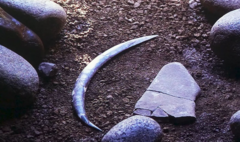The boomerang, found in Poland's Oblazowa Cave, has rewritten the narrative on ancient tools, being significantly older than previously estimated at 30,000 years. Archaeologists highlight its refined craftsmanship from a mammoth's tusk, showcasing the skills of humans from 42,000 years ago.
The boomerang was likely utilized for hunting, but its artistic significance might hint at ritualistic uses, given its exceptional preservation and carving intricacies, including features suggesting it was fashioned for right-handed throwers. Dr. Sahra Talamo from the University of Bologna emphasized its significance, stating it represents a "remarkable insight" into prehistoric human behavior and creativity.
While boomerangs are popularly associated with Aboriginal Australians, findings across continents indicate a broader historical usage. The oldest boomerang from Australia, made of wood, dates back only 10,500 years. Meanwhile, boomerang images in Australian rock art suggest a lineage that extends back 20,000 years. Other ancient boomerang fragments, including a 2,000-year-old oak piece discovered in the Netherlands, also reinforce the notion of this tool's wide-reaching cultural heritage.
The latest research, conducted by an international ensemble of scientists, was published in the journal PLOS One, contributing to a deeper understanding of human history and the evolution of tool-making practices.




















